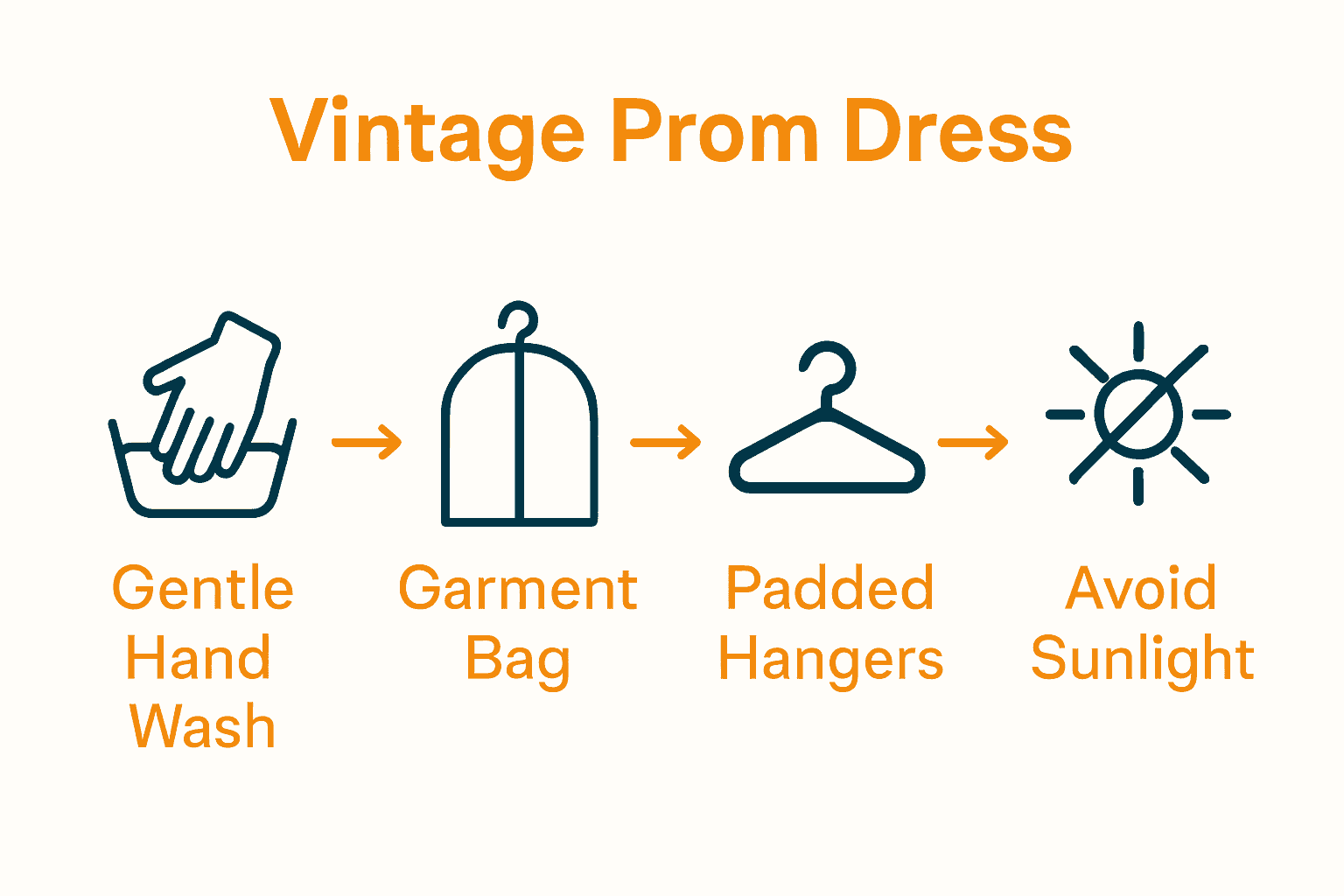Vintage Style Prom Dresses: Complete Guide UK
- Emma

- 4 hours ago
- 7 min read
Vintage style prom dresses do more than make a statement—they reflect pieces of history worn with pride. Vintage fashion refers to clothing from 30 to 100 years ago, each era offering its own unique flair and craftsmanship. For anyone seeking individuality and timeless beauty for prom night, these dresses capture something no modern look can replicate. Discover how a sense of nostalgia, intricate details, and iconic silhouettes set vintage style apart, helping you stand out with confidence and charm.
Table of Contents
Key Takeaways
Defining Vintage Style Prom Dresses
Vintage style prom dresses represent more than just elegant garments – they are living historical narratives crafted with exceptional craftsmanship and design. According to Wikipedia, vintage clothing refers to garments originating from previous eras, typically between 30 and 100 years old, reflecting distinctive styles and trends of their respective time periods.
These remarkable dresses capture the essence of bygone fashion epochs, allowing wearers to express profound individuality and nostalgia. As vintage fashion enthusiasts understand, each dress tells a unique story through its intricate design elements, fabric choices, and construction techniques. Understanding vintage style means appreciating the nuanced details that distinguish a genuine vintage piece from modern interpretations.
In the context of prom dresses, vintage styles typically draw inspiration from iconic decades like the 1950s and 1960s, featuring characteristic silhouettes such as:- Full circle skirts with defined waistlines- Tea-length hemlines - Structured bodices with sweetheart necklines- Delicate embellishments like pearl accents or lace overlays
Each vintage prom dress represents a miniature historical artifact, transforming personal style into a celebration of fashion’s rich evolutionary journey. By choosing a vintage style prom dress, you’re not just selecting an outfit – you’re curating a wearable piece of cultural heritage that transcends contemporary fashion trends.
Popular Eras and Iconic Silhouettes
Vintage prom dress styles are a vibrant journey through fashion history, with each decade offering distinctive silhouettes that capture the essence of its time. According to Wikipedia, the ball gown has been a staple of formal attire since the 19th century, characterised by an off-the-shoulder design with a low décolletage and a full, bouffant skirt that emphasises elegance and grandeur.
The 1950s represent a golden era for prom dress design, featuring cinched waistlines, full circle skirts, and romantic feminine details. This period celebrated hourglass figures with structured bodices and voluminous skirts that created a dramatic silhouette. Exploring fashion eras reveals how each decade contributed unique design elements that continue to inspire contemporary vintage-style prom dresses.
Key iconic silhouettes across different eras include:- 1920s: Dropped waist, straight shift dresses with fringe and beaded details- 1950s: Fitted bodices with full circle skirts, often in pastel colours- 1960s: A-line dresses with shorter hemlines and bold geometric prints- 1970s: Wrap dresses with flowing fabrics and bohemian-inspired designs
Here’s a summary of iconic prom dress styles by decade:
*The Delphos gown is an early 20th-century example of innovative pleating.
Interestingly, the Delphos gown, created in 1907 by Mariano Fortuny and featuring finely pleated silk that clings to the body, demonstrates how vintage fashion continuously reinterprets historical design principles.
By selecting a vintage-style prom dress, you’re not just choosing an outfit, but embracing a piece of fashion history that transcends time and trends.

Signature Fabrics and Decorative Details
Vintage prom dresses are defined by their extraordinary fabric selections and intricate decorative details that transform each garment into a wearable piece of art. According to Wikipedia, traditional ball gowns showcase luxurious fabrics such as satin, silk, taffeta, and velvet, complemented by exquisite embellishments like lace, pearls, sequins, embroidery, ruffles, ribbons, rosettes, and ruching.
The fabric choice in vintage prom dresses goes far beyond mere aesthetics – it represents a nuanced understanding of texture, movement, and historical design principles. Timeless vintage fashion icons reveal how different eras celebrated specific fabric characteristics, from the crisp structured cottons of the 1950s to the fluid, draping materials of the 1970s.
Key decorative elements that define vintage prom dress fabrics include:- Delicate hand-sewn beadwork- Intricate lace overlays- Carefully placed sequin embellishments- Vintage-inspired embroidery techniques- Pleated fabric panels- Strategically placed ruching and gathering
Interestingly, techniques like the Delphos gown’s unique pleating method demonstrate how fabric manipulation can transform a simple material into an extraordinary garment. By selecting a vintage-style prom dress with carefully chosen fabrics and decorative details, you’re not just wearing a dress – you’re showcasing a piece of textile artistry that tells a rich, complex story of fashion history.
How to Choose the Perfect Vintage Prom Dress
Selecting the ideal vintage prom dress is an art form that combines personal style, historical appreciation, and individual expression. According to Wikipedia, when choosing a vintage prom dress, it’s crucial to consider the era that best complements your personal style and body shape, while ensuring the garment is in good condition and paying close attention to fabric integrity.
Body shape plays a pivotal role in vintage dress selection. Different decades celebrated various silhouettes – the 1950s emphasised hourglass figures with nipped waists, while the 1960s introduced more streamlined, A-line designs that worked beautifully for multiple body types. Fave Five - Vintage Party Dresses highlights how understanding your body’s unique proportions can help you select a dress that not only looks stunning but feels incredibly comfortable.
Key considerations when choosing your perfect vintage prom dress include:- Assess your body shape and preferred silhouette- Check the dress’s condition and potential alteration needs- Consider the era’s design aesthetic- Evaluate fabric quality and potential wear- Determine your comfort and movement range- Plan potential accessory pairings

Embracing the thrift store chic approach allows you to create a uniquely personalised outfit by combining your vintage prom dress with contemporary accessories. This strategy not only promotes sustainability but enables you to express your individual style, transforming a historical garment into a modern fashion statement that truly reflects your personality.
Caring for and Preserving Vintage Dresses
Preserving the delicate beauty of vintage prom dresses requires a thoughtful and meticulous approach. According to Wikipedia, proper vintage clothing care involves gentle cleaning methods, with specific attention to storing garments in a cool, dry place away from direct sunlight, using padded hangers or acid-free tissue to maintain their original shape and prevent potential damage.
Each vintage dress demands a unique preservation strategy based on its fabric, construction, and historical significance. Vintage Clothing Care: Tips and Tricks for Preserving Your Treasures emphasises the importance of understanding each garment’s specific requirements, from delicate silk pieces to more robust cotton constructions.
Key preservation techniques for vintage prom dresses include:- Hand wash or professional dry clean only- Use pH-neutral, gentle detergents- Store in breathable garment bags- Avoid plastic storage containers- Keep away from direct heat and sunlight- Use acid-free tissue for padding and protection- Rotate hanging positions to prevent fabric stress

Interestingly, some vintage pieces like the Delphos gown require extraordinary care, such as being stored rolled instead of folded to prevent structural damage. By treating your vintage prom dress as a cherished historical artifact, you’re not just maintaining a garment – you’re preserving a piece of fashion history that can be appreciated for generations to come.
Discover Your Perfect Vintage Prom Dress Today
Choosing a vintage style prom dress means embracing a unique piece of fashion history that fits your body shape and personal style. The challenge lies in finding a dress that combines authentic era design, exquisite fabrics, and delicate decorative details while ensuring comfort and condition. At My Vintage, we understand how important it is to select a dress that truly reflects your individuality and celebrates sustainable fashion.

Explore our carefully selected collection of vintage clothing that spans decades from the 1940s to the 1990s. Each item is a timeless treasure crafted with the same attention to fabric quality and historical detail discussed in the guide. Don’t miss your chance to own a remarkable vintage prom dress that tells a story and lasts for years to come. Start your journey at My Vintage now and step confidently into prom night with style and grace.
Frequently Asked Questions
What defines a vintage style prom dress?
Vintage style prom dresses are garments that reflect fashion trends from past decades, typically between 30 and 100 years old. They are characterised by unique silhouettes, fabric choices, and intricate designs that embody the essence of the eras they represent.
Which eras are most popular for vintage prom dresses?
Popular eras for vintage prom dresses include the 1920s, 1950s, 1960s, and 1970s. Each decade offers distinct silhouettes, such as dropped waist dresses from the 1920s, fitted bodices with full skirts from the 1950s, A-line styles from the 1960s, and wrap dresses from the 1970s.
How do I choose the right vintage prom dress for my body shape?
To choose the right vintage prom dress, assess your body shape and identify which silhouettes flatter you best. The 1950s silhouette, which emphasises hourglass figures, is ideal for some, while A-line designs from the 1960s offer a versatile option for various body types.
What are key care tips for preserving vintage dresses?
To preserve vintage dresses, use gentle cleaning methods such as hand washing or professional dry cleaning with pH-neutral detergents. Store dresses in a cool, dry place using breathable garment bags and avoid direct sunlight to maintain their original condition.
Recommended








Comments